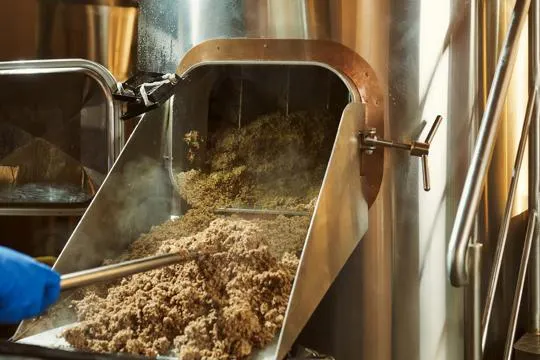Summary of key points
The primary difference is in their purity and use. Grain alcohol, also known as ethanol, is a highly distilled form of alcohol, often reaching up to 95% alcohol by volume, and is used in both beverages and as a solvent or cleaning agent due to its high purity. Vodka, distilled to a lesser degree, typically contains 40% to 60% alcohol by volume, and is consumed as a drink, appreciated for its smoothness and slight flavor variations depending on its source ingredients.
Ever stood in the liquor aisle, scratching your head at the difference between grain alcohol and vodka? We’ve all been there.
Grain alcohol and vodka seem like distant cousins at a family reunion. One’s the life of the party; the other’s a bit more refined.
I remember this one time, we decided to conduct a little “experiment” at a gathering. The goal? See if anyone could truly tell them apart. Spoiler alert: hilarity ensued.
Grain alcohol is like that overachiever in class – potent and straight to the point. Vodka, on the other hand, is the friend you invite over for a chat – smooth, subtle, and plays well with others.
Breaking it down, it’s not just about the kick, but the experience. Next time you’re eyeing those bottles, think of us and chuckle. Maybe conduct your own “experiment.”
What is Grain Alcohol?

Grain alcohol, also known as ethanol, is a powerful and highly concentrated type of alcohol.
It is made by fermenting grains such as corn, wheat, or barley.
With up to 95% in alcohol content, grain alcohol is much stronger than other alcoholic drinks.
It is a versatile alcohol.
With its potency, it can be used for multiple purposes, not just for drinking.
It is a strong solvent, used in cleaning products, perfumes, flavorings, hand sanitizers, and medical products.
Despite its popularity, grain alcohol has to be consumed responsibly.
Its high alcohol content makes it more likely to get someone drunk quickly.
It is essential to know your limits and be careful with grain alcohol.
What is Vodka?

Vodka is a popular spirit with its clear and odorless properties.
Distillation is the process of making it, which involves converting fermented items, like grains or potatoes, into alcohol.
It is known for its neutral taste, which allows it to blend easily with different flavors.
People often enjoy it neat or as a base for cocktails.
Different countries have their own regulations and standards for vodka production.
In Russia and Poland, it is typically made with fermented wheat or rye.
But, today, other raw materials like corn or potatoes can be used.
All vodka must go through multiple distillations to reach the desired purity.
A unique aspect of vodka is its ability to be infused with different flavors.
This happens by adding fruits, herbs, or spices and letting them steep.
This enables vodka to have distinct taste notes, making it an ideal choice for cocktail lovers who want to try new flavor combos.
In short, vodka is more than just an odorless alcohol.
Its neutral taste makes it great for cocktails or alone.
With its production methods and flavor infusions, vodka continues to capture drinkers worldwide.
Differences Between Grain Alcohol and Vodka

Grain alcohol and vodka might look alike, but they’re not the same.
Ingredients and Production Process
Grain alcohol and vodka may look alike. But they are different.
Grain alcohol is made from grains such as corn.
Vodka can be made from different sources.
To make grain alcohol, the grains are fermented, then distilled.
Vodka is distilled multiple times to make it pure, without flavor or aroma.
Also, grain alcohol has a higher proof than vodka.
All these variations create unique qualities for both spirits.
Alcohol Content
Grain alcohol and vodka may look similar but their alcohol content varies wildly.
Vodka usually has an alcohol content between 35-50%, while grain alcohol can reach up to 95%.
This makes grain alcohol much stronger than vodka.
When it comes to production, grain alcohol is made from fermented and distilled grains like corn or wheat.
Vodka can be made from various agricultural products, like potatoes or grapes, which contributes to its unique flavors and aromas.
It is important to remember that grain alcohol is super strong and should not be consumed in its pure form.
It is better used for industrial purposes like fuel and solvents.
Vodka, on the other hand, is popularly enjoyed as an alcoholic beverage around the world.
Flavor Profile and Taste
Grain alcohol and vodka have different flavor profiles and tastes.
Grain alcohol has a robust, sweet and grainy flavor.
Whereas, vodka is known for its neutral taste.
The grains used in grain alcohol’s production give it a complex flavor.
But, vodka goes through distillation processes to strip away impurities and flavors.
Vodka is smooth and refined in taste.
Furthermore, grain alcohol has a higher ABV compared to vodka’s 35-50%.
These differences can be used to choose the right spirit for a beverage.
Common Uses
Grain alcohol and vodka could look alike, but they have different common uses.
Grain alcohol is used as a solvent in major industries.
Vodka, however, is mainly consumed as a beverage. There are other details too.
Grain alcohol is used as a solvent.
It has high alcohol content, making it ideal for extracting fragrances and flavors in the pharmaceutical and cosmetic industries.
Vodka is well known as a popular drink.
Its neutral flavor makes it great for cocktails or drinking it straight.
It is often mixed to make signature drinks at bars and get-togethers.
Grain alcohol is also used to make fuel.
Its high ethanol content works with engines that run on biofuels.
This eco-friendly application is gaining attention for looking for alternative fuel sources.
To sum up, grain alcohol is a solvent and can be used to extract things in the pharma and cosmetic industries.
Vodka is mainly used as a beverage, thanks to its neutral flavor.
Finally, grain alcohol is explored as a potential biofuel source due to its high ethanol content.
Similarities Between Grain Alcohol and Vodka

Grain alcohol and vodka share many traits with regards to their base ingredients and production process.
Both are made from grain and distilled to reach high alcohol content.
The main difference is in their purity – grain alcohol is usually 95% pure, aka 190 proof.
Vodka, on the other hand, has a lower proof level between 80-100.
This difference in purity can affect taste, smoothness and drinking experience.
In terms of utilization, both beverages are great mixers for fruity, citrusy or herbal drinks.
They are also employed in cooking – they extract flavors from herbs, spices, fruits and botanicals.
Plus, their high alcohol content makes them great for preserving or infusing ingredients.
It’s important to note that grain alcohol is more potent than vodka.
Therefore, caution is advised when consuming it neat or using it in cocktails without dilution.
Vodka, however, offers a milder experience for those who prefer less intensity.
Cocktails and Mixology with Grain Alcohol and Vodka
Grain alcohol, aka neutral spirits, and vodka may seem similar – but they have major differences when it comes to cocktails and mixology.
Grain alcohol is distilled at a high proof, usually over 190 proof.
Its potency makes it a popular pick for homemade tinctures, but not for drinking neat.
Vodka, on the other hand, undergoes multiple distillations to get its clean, smooth flavor.
It can be made from grains, potatoes, or grapes, and is usually distilled at a lower proof.
Vodka is often diluted with water to create subtle flavors that enhance cocktails without overpowering them.
Grain alcohol is best for powerful concoctions like flaming shots or strong punches.
Its neutral taste makes it easy to blend with other ingredients, without changing the flavor.
Vodka’s clean taste pairs well with a range of flavors, making it great for classic martinis or tropical drinks – letting your chosen ingredients take the spotlight.
Which One to Choose for Different Purposes?
Grain alcohol and vodka differ in their uses.
Grain alcohol is stronger, so it’s popular for creating homemade drinks with higher alcohol content.
Vodka has a neutral taste, making it great for mixing with other ingredients for cocktails.
Strength-seekers might prefer grain alcohol, as it packs a punch.
Vodka works well in cocktails, blending with other flavors.
It’s the base for many classic drinks such as martinis and screwdrivers.
It’s all about personal preference.
Knowing the characteristics of each will help you pick the drink for your tastes.
Conclusion
Grain alcohol and vodka are both very popular spirits today, but they are not the same.
Grain alcohol has a far higher ABV than vodka, making it more potent and able to be used in a much wider range of cocktails.
Aside from flavor nuances and top-shelf qualities, the biggest difference between grain alcohol and vodka is strength.
Knowing this difference can help you choose the right spirit for your favorite drinks, whether you’re looking for a strong yet smooth flavor or something milder.
Many mixologists swear by one or both for concocting signature libations depending on their bases.
Ultimately, when it comes to grain alcohol vs vodka, it’s up to you – with each offering so much unique flavor and quality – so don’t be afraid to try a few varieties and dive into the thrilling world of spirited exploration.

Leave a comment